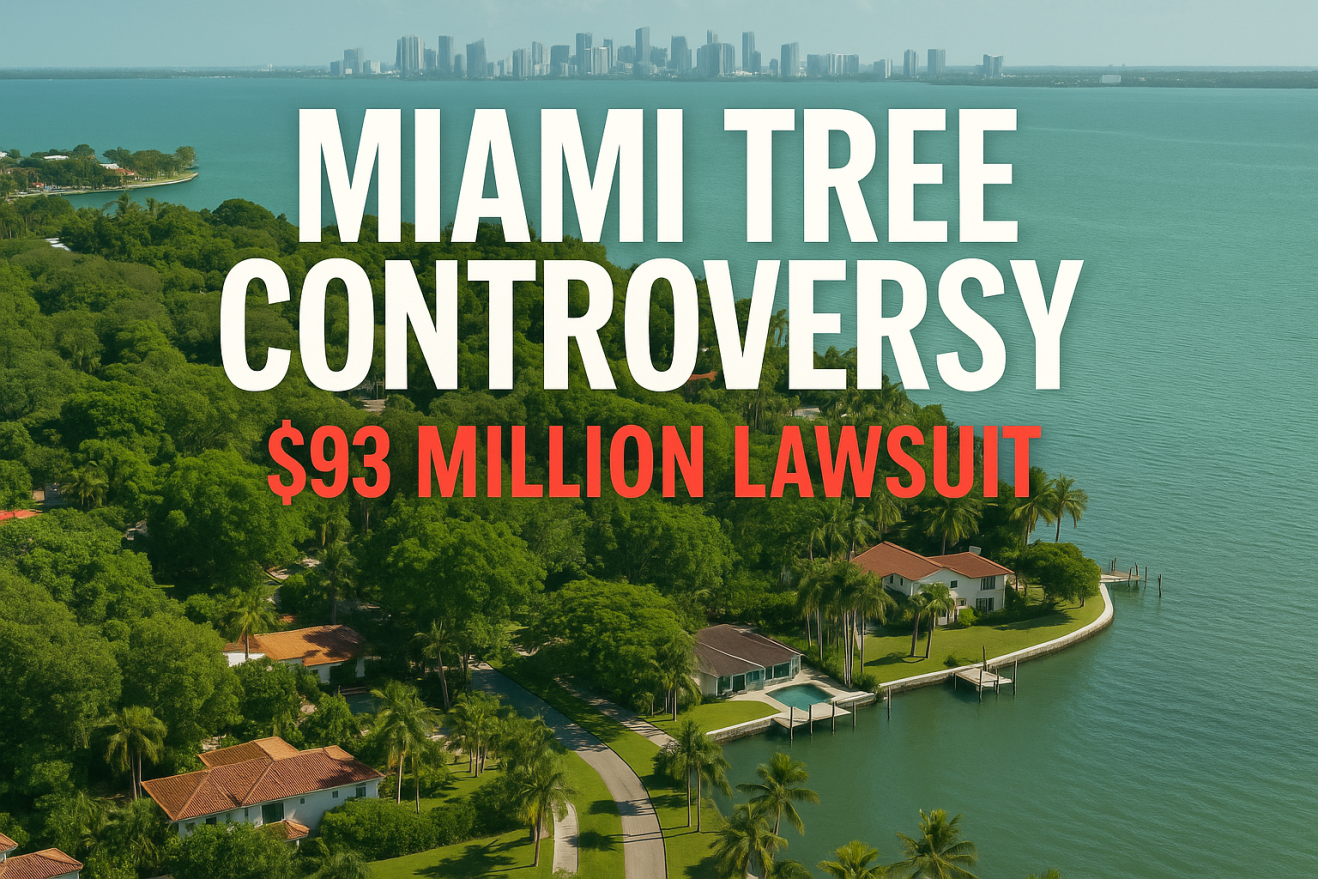MIAMI – A century-old oak tree in Miami’s historic Morningside neighborhood has become the unlikely symbol of a massive legal and financial battle that could cost taxpayers up to $93 million, as residents mobilize against Commissioner Damian Pardo’s controversial sidewalk expansion project.
The $93 Million Question: When Tree Removal Becomes a Legal Nightmare
What began as a routine infrastructure improvement has escalated into one of Miami’s most expensive municipal controversies. Residents of the prestigious bayside neighborhood discovered that a 75-year-old oak tree was removed without proper notification, triggering a cascade of legal challenges that could invoke Florida’s Bert Harris Act, which protects property owners when government projects impact private property values.
The sidewalk project, championed by Commissioner Pardo as a safety improvement, has instead become a cautionary tale about the intersection of urban development, environmental protection, and property rights in one of America’s most valuable real estate markets.
Historic Morningside: Where Every Tree Matters
The Morningside Historic District, established in the 1920s, represents one of Miami’s most architecturally significant neighborhoods. The tree canopy, featuring mature oaks, royal palms, and native species, contributes significantly to both the area’s historic character and property values that often exceed $2 million per residence.
“This isn’t just about one tree,” explained neighborhood spokesperson Maria Gonzalez, a longtime resident whose property borders the affected area. “It’s about the systematic destruction of what makes Morningside special – our historic tree canopy that took decades to establish.”
The Environmental Impact Assessment
Environmental experts have raised concerns about the project’s broader ecological implications. Miami-Dade County’s Environmental Resources Management department had not completed a comprehensive tree survey before the removal began, according to documents obtained through public records requests.
Dr. Sarah Martinez, an urban forestry specialist at the University of Miami’s Rosenstiel School, noted that mature oak trees in South Florida provide critical ecosystem services including stormwater management, air quality improvement, and urban heat island mitigation – services valued at thousands of dollars annually per tree.
Legal Ramifications: The Bert Harris Act Threat
The most significant development came Wednesday when residents’ attorneys filed a formal legal warning with Miami City Hall, citing potential violations of the Bert Harris Private Property Rights Protection Act. This Florida statute allows property owners to seek compensation when government actions reduce property values.
The legal notice, addressed to Mayor Francis Suarez, the city attorney, and city manager, specifically names Commissioner Pardo and warns that the concrete sidewalk expansion could trigger claims totaling up to $93 million under the act’s provisions.
“When you remove mature trees and install concrete in a historic neighborhood, you’re not just changing the landscape – you’re potentially destroying property values that residents have invested in for decades,” said attorney Robert Chen, who represents several affected homeowners.
Commissioner Pardo’s Defense: Safety vs. Aesthetics
Commissioner Pardo has defended the project as a necessary safety improvement, citing pedestrian accessibility concerns and Americans with Disabilities Act compliance requirements. His office released a statement emphasizing the city’s commitment to creating walkable, accessible neighborhoods.
“We cannot allow aesthetic preferences to override fundamental safety requirements,” Pardo stated in a recent city commission meeting. “Every resident deserves safe, accessible sidewalks, regardless of the neighborhood’s historic designation.”
However, critics argue that alternative designs could have preserved the tree while meeting accessibility standards, pointing to successful examples in other historic districts including Coral Gables and Miami Beach.
Property Values and Economic Impact
Real estate experts have begun analyzing the potential financial implications of the tree removal and sidewalk changes. Miami Association of Realtors data shows that mature tree coverage can add 10-15% to property values in historic neighborhoods, translating to hundreds of thousands of dollars for individual homes.
Appraiser Jennifer Walsh, who specializes in historic properties, noted that the Morningside market depends heavily on the neighborhood’s character and environmental amenities. “When you start removing the elements that make a neighborhood unique, you risk creating a domino effect that impacts every property value in the area,” she explained.
Community Mobilization and Political Pressure
The controversy has galvanized the typically quiet Morningside community into unprecedented political action. Residents have organized through social media, created a legal defense fund, and begun attending city commission meetings in large numbers.
The Morningside Civic Association has hired both environmental and legal experts to challenge the project’s approval process, arguing that proper community notification and environmental review procedures were not followed.
“This is about more than trees,” said association president David Rodriguez. “It’s about whether residents have any say in how their neighborhoods develop and whether the city follows its own rules when it comes to historic preservation.”
Citywide Implications: A Precedent for Development
Urban planning experts warn that the Morningside controversy could set important precedents for development throughout Miami’s historic neighborhoods. The city’s Planning and Zoning Department is reportedly reviewing similar projects in other areas following the legal challenges.
Dr. Michael Thompson, a urban planning professor at Florida International University, noted that Miami faces increasing pressure to balance development needs with historic preservation as the city continues to grow and densify.
Environmental Justice and Climate Considerations
The tree removal has also raised broader questions about environmental justice and climate resilience in Miami. As the city faces increasing challenges from sea-level rise and extreme heat, urban forestry experts argue that preserving mature trees becomes even more critical.
The Miami-Dade Climate Resilience Committee has identified urban tree canopy as a key component of the region’s climate adaptation strategy, making the Morningside controversy particularly significant for citywide policy.
Looking Forward: Potential Resolutions
As legal proceedings move forward, several potential resolutions have emerged. City officials are reportedly exploring compromise solutions that could include enhanced tree replacement programs, modified sidewalk designs for future phases, and improved community notification processes.
The Parks and Recreation Department has proposed a comprehensive tree replacement plan, though residents argue that newly planted trees cannot replace the ecosystem services and aesthetic value of mature specimens.
The Broader Context: Miami’s Development Challenges
The Morningside tree controversy reflects broader tensions in Miami’s development landscape, where rapid growth often conflicts with historic preservation and environmental protection goals. Similar disputes have emerged in neighborhoods including Coconut Grove, Design District, and Wynwood.
As Miami continues to attract new residents and investment, city officials face increasing pressure to balance development needs with the preservation of neighborhood character and environmental resources that make the city attractive to residents and visitors alike.
The outcome of the Morningside case could influence how Miami approaches similar challenges throughout its historic neighborhoods, potentially affecting millions of dollars in property values and setting precedents for community involvement in municipal decision-making.
















